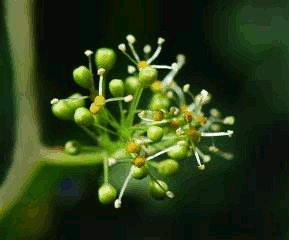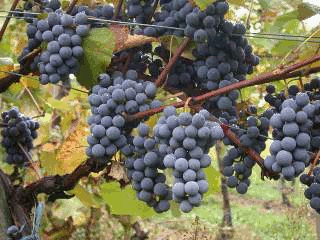Grape
Scientific Name: Vitis vinifera
Climate: Temperate, temperate hot
Plant Description: It is a climbing plant up to 30 meters long, has tendrils and deciduous leaves with long petioles webbed-cordate (3 to 5 lobes) and serrated edge. The scented flowers are greenish in color, and appear in hanging panicles. The fruits - grapes - grow in clusters of 15 to 300. Depending on the variety of the grape, they can be of different colors: crimson, black, dark blue, yellow, green, orange and pink. The grapes are spherical in shape, fleshy and juicy. The shell is thin but strong. The pulp is aromatic and sweet.
Grape is native to Mediterranean region, Central Europe, and southwestern Asia
Cultivation: Full sun. A small amount of shade in the afternoon won't hurt. It needs deep, well-drained and loose soil. Prefers sandy-loam soil with sufficient organic matter. It is resistant to winter frosts, but this resistance is reduced after sprouting, when the first leaves appear. The optimum temperature for its development ranges between 15 to 25 C.
Propagation by cuttings, layers and seeds.
Propagation by cuttings - cuttings 30 - 45 cm long with 3 or more shoots are taken from dormant plants in the fall or winter. They are stored in a cool, humid environment until the beginning of the growing season. Before planting, the roots of the cuttings must be immersed in water with a rooting agent. Prepare the pots with well-fertilized and drained soil. Put inside the pot at 5 to 8 cm depth. Keep the soil moist. Sprouts will appear in a few weeks. Allow your cuttings to establish and take root firmly in pots before transplanting them outdoors in early to mid-summer.
For each plant, dig a planting hole 30 cm deep and 30 cm wide. Leave between 2 to 3 meters of distance between the plants.
Propagation by layering: means burying a portion of an established vine until it takes root. A mother grape plant is chosen and a young, flexible branch, 1 to 3 years old, is sought. This branch is bent near ground level until it reaches the ground. A portion of the vine is buried under the ground, making sure to bury at least 1 knot. Nodes are where new roots are most likely to form when buried. Make sure to leave the end of the vine above the ground so that it continues to grow. The new grape plant should form roots within a few months and can be separated from the mother plant once it is well rooted.
Grapes can be propagated from seed, but they will not be identical to the mother plant. Growing grapes from seed is an important tool for professional growers interested in developing their own variety of grape.
After planting, water the vines regularly during the first year. During that year the root system needs to grow and establish itself to allow shoot growth. It is necessary to wait between watering till the soil dries at least the superficial part of the earth (5 cm).
The vines need some kind of support or they will crawl across the ground. The support can be as simple as a pole in the ground to support the trunk of the vine.
For the first two to three years, each spring, apply compost around the base of the vines. Grape vines grow vigorously and may need a nutrient boost each year. You may not have to do them as the vines mature; it all depends on how the plant looks.
In the first couple of years, the vine should not be allowed to produce fruit. It needs to strengthen its root system before it can support the extra weight of the fruit. Prune annually when the vines are dormant (March or April). Frequent pruning ensures higher grape production. All shoots are pruned except the most vigorous one, which is trimmed so that only two or three buds remain. The resulting plant forms a strong main stem, similar to a small trunk. As it grows, the vine is tied to a two-meter high stake. Normally it is pruned so that the plant is at a height between 1 to 1.5 m.
If the grapes are not ripening, pinch off some of the foliage to let in more sunlight. The grapes will no longer ripen once they are picked from the vine. Try a few to see if they are matured enough before the harvest, usually late summer-early fall. The harvest is done manually, collecting the entire bunch, without damaging it. The grapes must have the same degree of ripeness, shape and color. The harvest takes between thirty and 45 days.
 Uses: It is eaten as fresh fruit, in jam, gelatin, drunk as juice, raisins, vinegar, seeds are pressed to convert them into grape seed extract, and grape seed oil. Grapes are the main material in wine making.
Uses: It is eaten as fresh fruit, in jam, gelatin, drunk as juice, raisins, vinegar, seeds are pressed to convert them into grape seed extract, and grape seed oil. Grapes are the main material in wine making.
It also has medicinal properties: supporting the health of the colon, helping with high blood pressure, diabetes and cancer.
Pests and Diseases: They can be attacked by fungi if there is an excess of humidity and by insects if they suffer intense drought.
Cluster moth or Lobesia; Aphids; Japanese beetles; Sparganothis pilleriana; Green mosquito; Phylloxera; Mealybugs; Gray worms.
References:
https://www.gob.mx/cms/uploads/attachment/file/257085/Potencial-Uva.pdf
https://extension.umn.edu/fruit/growing-grapes-home-garden#feeding-and-weeding-986012
Information about pests and treatment: https://www.agromatica.es/plagas-de-la-vid
http://www.fertilizante.info/guia-de-plagas-y-enfermedades-de-la-vid/
En Espanol: Uva

